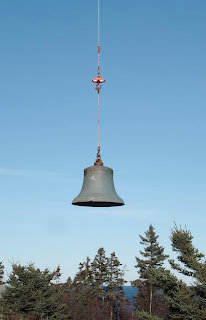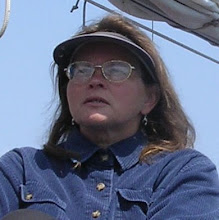July 7, 2011, saw another gathering of those keenly interested in the Swallowtail Lighstation. The flag was raised for the first time this year with an RCMP officer in attendance as O Canada was sung. A plaque was also unveiled to commemorate the sacrifice of Elodie Ingalls Foster in her role as a lightkeeper in 1936. Family members were in attendance to unveil the plaque that was later installed on the lighthouse where a terrible accident resulted in her clothes catching fire in the evening of August 7. Despite medical care, she died the next day.
Text on the plaque reads:
In Memory Of
Elodie Ingalls Foster
19 February 1892 - 8 August 1936
In the early evening of August 7, 1936, Elodie Ingalls Foster in her capacity as second keeper at Swallowtail attempted to light the lamp in the lighthouse tower. She had carried out these duties previously and for unknown reasons the flammable liquid used soon engulfed her in flames. She was able to get out of the tower and reached the living quarters of Swallowtail. She was quickly found by family members and medical attention was called. Despite their best efforts Mrs. Foster died from her injuries the following day.
The death notice in 1936 read:
Swallow Tail Light
Mrs. Thos. Foster, Wife of Lightkeeper, Suffers Fatal Injuries in Performance of Duties As Second Keeper
ALONE AT TIME OF ACCIDENT
North Head, Aug. 10 – (Special) – Death came to Mrs. Thomas Foster late Saturday afternoon as the result of severe burns received while lighting the lamp at the Swallow Tail Lighthouse here. Friday evening directly following the accident it had been hoped and believed that she might survive but as the hours passed medical advice saw that the end was only a matter of a short time.
As second keeper of the light and alone at the time with the exception of her three-year-old granddaughter, Wilhelmina Knyff, Mrs. Foster had taken her young company to the light tower. She adjusted the lamp parts and applied wood alcohol with a torch and somehow, not thoroughly understood, the second application spilled the inflammable liquid which quickly spread, catching her clothing. In a moment she was a mass of flames and tearing at her clothes to rid her body of the fire, raced down the long winding flights of stairs to the living quarters of the light.
The terrified little girl left in the light started from the tower which was now afire and fell down the deep stairs. She was injured slightly about the head.
Just at that time Mrs. Foster’s two daughters, Miss Ruth and Mrs. Eddy Knyff, her son, Leonard, and Junior Ingersoll, a companion, rushed in. Horror stricken with what they found Len had presence of mind enough to immediately seek medical attention and his father at Southern Head Light, and to extinguish the fire in the tower.
Suffering intense pain, Mrs. Foster was conscious at times, relating as nearly as could be, what had happened. A greater part of her body had been seared by flames and on through the night and during Saturday her condition changed but little with the exception of a general weakening. Just a few hours before “lighting time” the end came.
Mrs. Foster was born at Ingalls’ Head, the daughter of the late Capt. and Mrs. Loran Ingalls and when her husband took over the appointment as keeper at the Southern Head Light, entered zealously into the work with him. She was considered as able and efficient second keeper in her own right and when changes in appointments came and they transferred to Swallow Tail she was made assistant keeper until Mr. Foster would be enabled to leave the light at Southern Head when that would be taken over by his successor. Their son, Leonard, has been acting as keeper at Swallow Tail.
The suddenness and painful conditions of her demise came as a shock to the entire island, to her family and immediate friends. She leaves to mourn her husband, Thomas H. Foster, one son, Leonard, two daughters, Ruth, at home, and Mrs. Eddy Knyff of Eastport, one brother, Paige Ingalls, of Black’s Harbour and Ingalls’ Head.






































